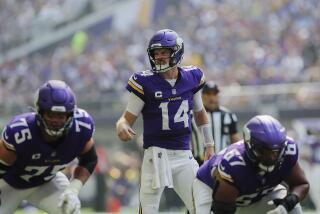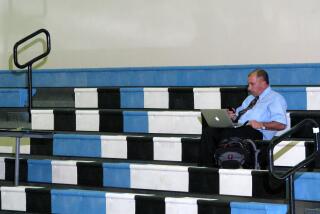He’s Pacific’s Center of Medical Attention : College football: Curt Crandall, who will snap the ball against Cal State Fullerton Saturday, has had surgery seven times since spring of 1988.
Curt Crandall has bounced around the University of the Pacific’s depth chart for 2 1/2 years, but he has been No. 1 on the Tigers’ medical charts throughout his college football career.
Crandall, who will start at center when Pacific plays Cal State Fullerton in Santa Ana Stadium Saturday, has been under the knife more than a linen napkin.
Since the spring of 1988, the former Estancia High School and Orange Coast College lineman has had surgery seven times to repair a variety of ailments. He has been a fixture in the Pacific training room, much like the whirlpool tub.
“He’s given our doctoral staff a lot of reps,” Tiger Coach Walt Harris said.
When Crandall says he has been fairly healthy this season, he’s not knocking on wood--he’s pounding it with both fists. He knows that, at any time, those knee ligaments could snap or that shoulder could pop out of the socket.
Even if he makes it through this season without adding to his classic scar collection, he’ll probably be back on the cutting edge in December, undergoing one more operation to repair a nagging shoulder injury.
Eight is enough as far as Crandall is concerned.
“No matter how many times you go through surgery, it always gets worse,” said Crandall, an All-Sea View League center at Estancia in 1985. “I feel a little more comfortable with it, but I hate needles and I hate going under (anesthesia). When you wake up, you’re shaking in pain.”
For 12 years, through Junior All-American leagues, junior high school, high school and junior college, Crandall played football with little pain. He had never suffered a serious injury or had an operation until he transferred to Pacific in the spring of 1988.
Since then, Crandall has been the sultan of surgery.
It started when school doctors, conducting a routine physical, discovered a hernia in Crandall’s abdominal region. He underwent surgery to repair the hernia and couldn’t train for several weeks before spring practice.
Crandall was fit enough to earn a starting offensive tackle position, but in the last scrimmage of the spring, he twisted his left knee. Crandall didn’t think the injury was serious, but the knee swelled during the summer, and a Newport Beach doctor discovered torn cartilage.
Surgery No. 2 caused Crandall to miss the first two weeks of practice for the 1988 season, but he was able to regain his starting job. Three weeks into the season, though, Crandall twisted the knee again and tore more cartilage.
Surgery No. 3 knocked him out for the remainder of the season, and Crandall used 1988 as a redshirt year.
Crandall, who was switched to center when Harris took over the program in 1989, made it through spring practice unscathed and almost made it through the 1989 season.
But in the 11th game of a 12-game season, Crandall fell on the artificial turf at Hawaii and tore ligaments in his right thumb. Surgery No. 4 put his hand in a cast for six weeks.
Two weeks after the thumb surgery, doctors performed arthroscopic surgery on Crandall’s left shoulder to repair torn cartilage and on his right shoulder to scrape inflammation off a joint.
Then, as Crandall was preparing for practice last spring, doctors discovered torn cartilage in his right knee and performed surgery No. 7. That knocked Crandall out of spring drills and back to third on the depth chart.
Crandall spent the summer in Stockton rehabilitating his knee, and recaptured his starting job in the third game of this season. The Tigers are struggling at 1-4, but if Crandall can make it through the season in one piece, he’ll consider the year a success.
“After about the fourth surgery, the coaches started getting frustrated and I was getting frustrated with myself,” said Crandall, a 6-foot-2, 245-pound senior. “It really was getting a little old. But it’s nice to play a season without too many problems.”
Crandall believes all the injuries have made him mentally tougher because he has learned to play with pain. Last season, his shoulder popped out of joint almost every week, but Crandall remained on the field.
“You just grit your teeth and bide your time,” he said.
Fortunately, none of the injuries has been career threatening, and Crandall doesn’t believe he’ll have problems walking or getting out of bed when he turns 35. All of his knee injuries involved lateral meniscus cartilage, not the more critical anterior cruciate ligament.
“I’m a little worried about what will happen later in life, but I don’t think there will be any major effects,” Crandall said. “Tearing cartilage isn’t too bad.”
But one might wonder about Crandall’s priorities. He’s 22, he’ll graduate with a degree in business next spring and he’s engaged to be married next fall. He admits he has virtually no chance of playing professional football and is more concerned about cracking the work force, not the NFL.
Is playing this sport worth all the pain, the injuries, the surgeries and the rehabilitations?
“Definitely,” Crandall said. “I love football. It’s in my blood.”
And vice versa.
More to Read
Go beyond the scoreboard
Get the latest on L.A.'s teams in the daily Sports Report newsletter.
You may occasionally receive promotional content from the Los Angeles Times.











